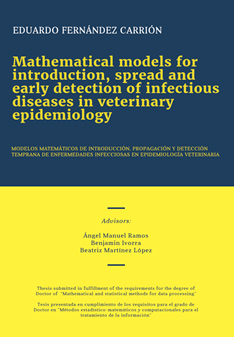Eduardo Fernández Carrión PhD Thesis

Next tuesday July 11, 2017 at the Mathematics Faculty of the UCM, Eduardo Fernánez Carrión will defend his doctoral thesis titled "Mathematical models for introduction, spread and early detection of infectious diseases in veterinary epidemiology" directed by Ángel Manuel Ramos, Benjamín Ivorra and Beatriz Martínez López.
Abstract:
Epidemiology is a discipline that studies the distribution and the factors related to the spread of (infectious) diseases in susceptible populations, and then uses this knowledge to control them. In this discipline, mathematical modeling plays a fundamental role in explaining the influence of potential risk factors, patterns of disease spread and the effects produced.
Applying mathematical models to epidemiology requires identifying the variables that influence the behavior of a disease in order to obtain a set of equations whose solution agrees with what happens in reality. The goal is to generate epidemiological models that not only explain the spread of diseases based on past experimental information, but also predict possible future scenarios. In this way, mathematical modeling is often the basis for decisions and practices aimed at preventing, controlling or eradicating disease.
The present thesis has focused on the development of three tools that cover surveillance, early detection and decision-making, each aimed at solving a real epidemiological problem in the field of animal health. This thesis is multidisciplinary in its approach and its scope: it combines methodologies in mathematics, statistics and computing to generate models useful to epidemiological and veterinary sciences.
The first tool developed in this thesis is based on a three-level deterministic numerical model to assess the risk of introducing vector-borne diseases by simulating wind-borne transport of insects from infected areas.
The second tool is a motion-based monitoring system that allows the detection of significant changes in the behavior of animals that develop febrile disease through computer vision techniques.
The third tool, called Be-FAST (Between and within Farm Animal Spatial Transmission), uses Monte Carlo methods to generate different scenarios of disease spread within and between farms based on the integration of stochastic variables.


